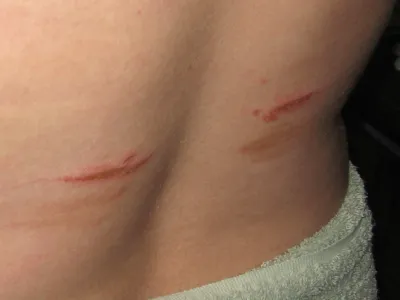Ever wonder why wearing a bra sometimes leaves your daughter with a rash, sore spots, or just plain cranky? You’re not alone. Bra irritating skin is a real issue for girls and women, especially when the bra rubs against the skin, traps boob sweat, or is made from materials that just don’t agree with sensitive skin.
Let’s break down what’s happening, why it matters, and what steps you can take to prevent skin chafing, rashes, and other skin conditions like intertrigo—without making it feel like a medical lecture.

Why Does a Bra Cause Skin Irritation?
When your daughter complains about a bra rash or sore skin around her breast area, there’s usually a simple reason: friction. A bra that’s too tight can dig into the skin, while a loose or ill-fitting bra rubs and leads to repeated rubbing. Over time, this causes skin irritation, redness, and in some cases, rashes and sores.
Some common bra problems that lead to irritation include:
Before we get into the list, think about how these everyday issues might be affecting your child:
- Chafe from Bra Straps: Bra straps that are too tight or too loose can rub against the skin and cause chafing.
- Underwires: Underwires in bras made with stiff materials can poke, dig, and lead to sore spots or even skin infections.
- Moisture Buildup: Sports bras with moisture-wicking fabric are supposed to absorb moisture, but if they trap sweat instead, you get heat rash and skin folds that are perfect for bacteria.
- Synthetic Bra Fabric: Bras made from synthetic materials can cause allergic reactions and are less likely to protect the skin than bras made from breathable fabrics like cotton or modal.
- Wearing the Same Bra Often: Not washing your everyday bra often enough leads to buildup of dead skin, sweat, and bacteria—another trigger for bra irritation.
| Problem Area | Typical Cause | What to Look For |
|---|---|---|
| Under the breasts | Band too tight, sweat | Redness, rash, soreness |
| Shoulders | Straps rubbing | Chafing, marks, soreness |
| Under the arms | Seams, friction | Itchy bumps, irritation |
| Between the breasts | Moisture, fabric rubbing | Rash, heat bumps |
Common Problem Areas for Bra Irritation
Skin Conditions Linked to Bra Irritation
If your daughter’s skin is especially sensitive, wearing a bra might be irritating for a few reasons:
- Intertrigo: This skin condition happens in warm, moist areas where skin folds or bra bands trap moisture. It can lead to red, itchy rashes and even skin infections.
- Contact Dermatitis: Allergic reactions to metals in bra underwires, latex in elastic, or chemicals in bra fabric can cause skin around the bra area to break out in itchy rashes.
- Bra Chafing: Sports bras that don’t fit right or aren’t made from breathable materials can cause friction and irritation, especially during hot and humid days or active play.
How to Prevent Bra Chafing, Rashes, and Sore Skin
Let’s talk about what you can do to prevent bra irritation and keep your daughter comfortable. Here are some tips that moms swear by—because every girl deserves a bra that fits and feels good:
It’s not just about picking a bra; it’s about making sure every detail works for your child’s sensitive skin:
- Choose the Right Bra Size: A well-fitted bra reduces friction, prevents chafing, and keeps bra straps from digging in.
- Go for Wire-Free Styles: Wire-free bras are less likely to cause irritation or allergic reactions, especially for girls with sensitive skin.
- Pick Bras Made from Breathable Materials: Cotton and modal bras are made from breathable fabrics that absorb moisture and are less likely to cause irritation.
- Look for Moisture-Wicking Fabrics: Sports bras with moisture-wicking technology help prevent skin chafing by drawing sweat away from the skin.
- Wash Bras Often: Wearing the same bra day after day can lead to buildup of sweat and dead skin. Clean bras protect the skin and reduce the risk of rashes.
- Avoid Bras with Harsh Chemicals: Some bras contain BPA, PFAS, or other chemicals that can lead to skin irritation and allergic reactions.
- Try Anti-Chafing Products: Petroleum jelly or anti-chafing balms can help protect the skin around problem areas, especially during sports or hot weather.
- Switch to Tag-Free and Seamless Bras: These styles reduce friction and are less likely to rub against the skin or cause irritation.

Why Moms Choose Suyiyi for Sensitive Skin
If you’re tired of hearing complaints about bra chafing, rashes, or sore skin, Suyiyi is here to help. Suyiyi bras are made from breathable, moisture-wicking materials that are less likely to cause irritation. Every bra is wire-free, tag-free, and designed for a comfortable fit—so your daughter can wear bras with confidence, not discomfort.
Ready to protect the skin and prevent bra irritation for good? Shop Suyiyi Sensory-Friendly Bras and see the difference a well-fitted, breathable bra can make.

FAQs
Why does my daughter’s bra rub against the skin and cause irritation?
If a bra rubs or fits too tight, it can lead to friction and irritation. Sometimes, the bra fabric or underwires can also cause skin chafing, especially in hot and humid weather.
Can sports bras cause skin chafing or rashes?
Yes, especially if they’re not made from moisture-wicking fabric or don’t fit properly. Sports bras that trap moisture or are too tight can lead to rashes and sores.
How often should my daughter wash her bra to avoid skin conditions?
Washing bras often—after every wear in hot weather or after sports—helps remove sweat, dead skin, and bacteria. This keeps the skin around the breast area healthy and less likely to develop rashes.
What’s the best bra style for sensitive skin?
Look for bras made from breathable materials, with a comfortable fit, and no underwires. Tag-free and seamless bras are especially good for girls with sensitive skin.
Are there ways to prevent bra rash and skin infections?
Yes! Make sure your child wears a bra that fits, is made from breathable, moisture-wicking fabrics, and is washed regularly. Using anti-chafing creams or petroleum jelly on trouble spots can also help prevent irritation.
Bra irritating skin doesn’t have to be a part of growing up. With the right bra, made from breathable materials and designed to reduce friction, your daughter can avoid skin chafing and rashes—and feel comfortable every day.
